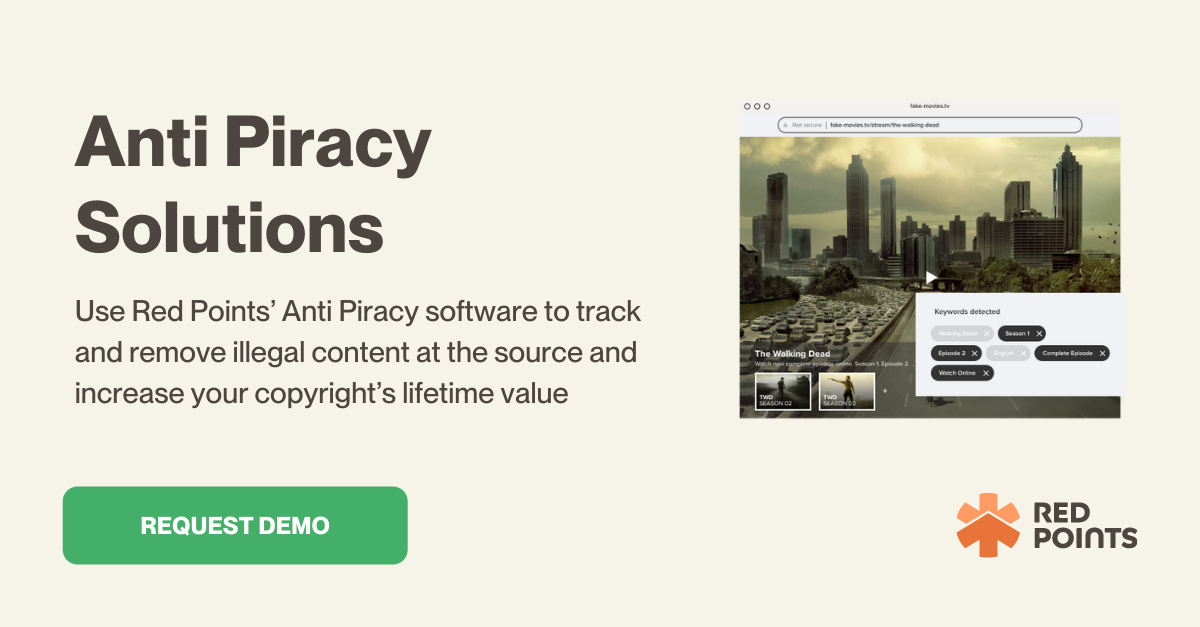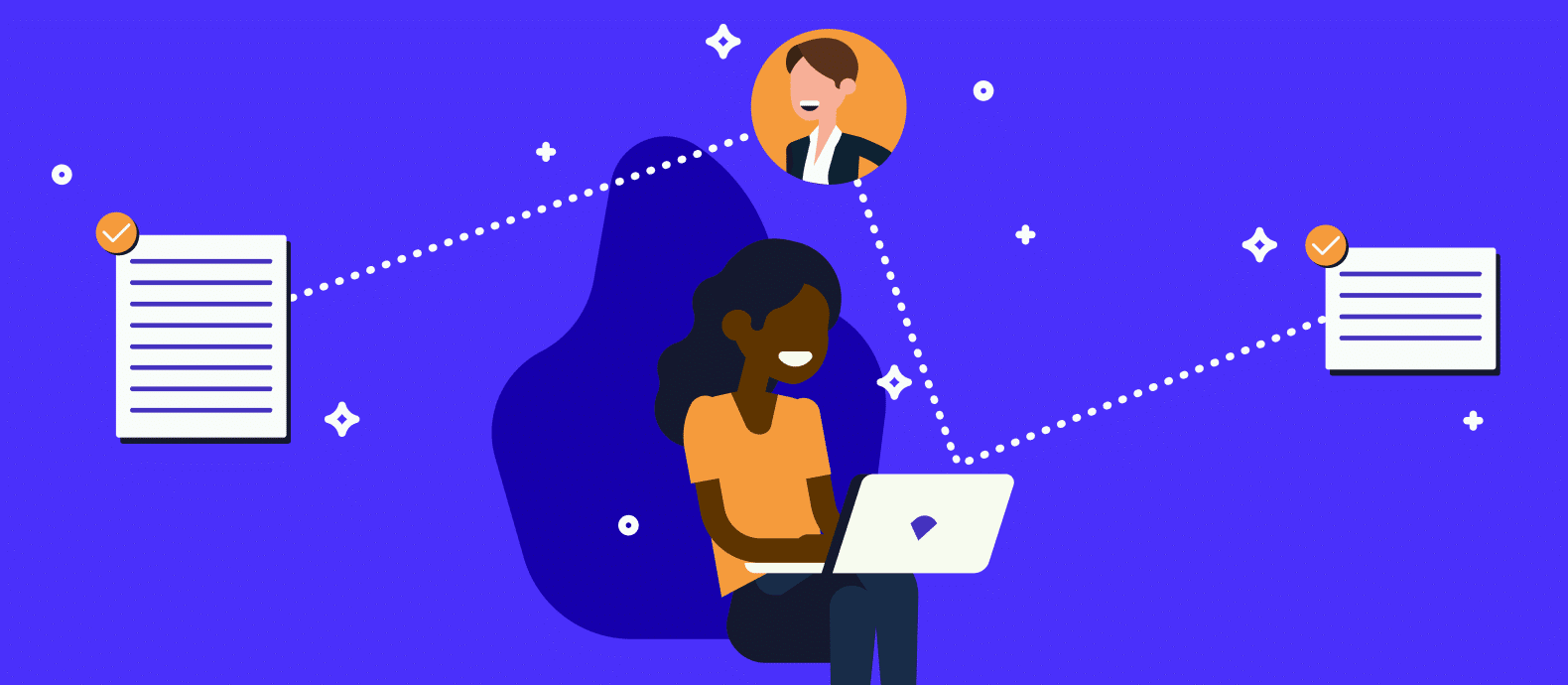Digital content comes in many different forms, but one thing is for sure: it’s a lot easier to copy, pirate, and share digital content than physical goods. Content creators not only need to deliver high-quality content to satisfy their customers, but they also need to spend effort guarding against content theft.
With internet connectivity increasing around the globe, piracy will only grow as an issue in the future. According to the Online TV Piracy Forecasts report from Digital TV Research, streaming revenue lost to piracy will reach $52 billion by 2022. Fortunately, brands have tools at their disposal to protect their online content. Today, we’ll talk about common types of content theft and how to protect your online content.
Summary
- Reasons to protect online content
- Types of content most likely to be pirated
- Common violations
- How to protect your content
Why you need to protect your content online
Once digital content gets copied and shared outside of intended distribution channels, it’s only providing a fraction of the value to its creators as it could be. With digital content, a single unlocked copy can proliferate into satisfying thousands of what would otherwise be paying customers. That’s why it’s so important to protect it. Protecting online content can minimize unauthorized sharing and copying and increase the lifetime value of your creations.
It can be especially important to protect some types of content during a specific window of time, as well. This can apply to entertainment series or business content based on current events or fresh research. The right protection can mean the difference between the success or failure of a market strategy that depends on new content reaching an eager audience.
Similarly to counterfeit or gray market products, the brand doesn’t have any control over the customer experience with pirated content. Links to popular pirated content can also mask phishing or malware campaigns. Fighting pirated content helps ensure customers have the right experience of the brand.
What kind of content is most likely to be pirated?
From e-learning content to live events and online publishing, there’s a wide range of content types that are targets for piracy.
TV on-demand & cinema
With COVID-19 lockdowns forcing many people inside for many months, there’s been a huge growth in entertainment piracy. According to MUSO, people across the world visited more movie and television piracy sites after the lockdown started. For example,
- In the UK, film piracy jumped 43% and TV piracy increased 30%
- In the USA, film piracy increased by 41% and TV piracy went up by 12%
- In Italy, film piracy increased by 66% and TV piracy jumped by 41%
Press & publishing
Piracy affects the publishing industry, as well. A decade ago, pirated books were scanned in low resolution and delivered in PDF files, which made them cumbersome to read. But today, you can get an exact copy of a book, magazine, or comic with all the right details and formatting for a variety of devices.
Live events & streaming
Streaming technology allows people to experience unlimited entertainment and even events in real time. In 2018, Netfilix alone accounted for 15% of total downstream traffic worldwide. After that, web videos on other sites accounted for 13.1% and YouTube accounted for 11.4%. With so many people streaming content, it’s no wonder that over 80% of global online piracy can be attributed to illegal streaming services.
Streaming isn’t limited to shows and movies. MUSO found that people attended pirated sporting events online over 362 million times in 2019. One of the most popular pirated streaming sites, Buffstream, has become more popular than Fox Sports, MLS, and TNT. Today, if it’s happening live on a network site, it’s happening live somewhere on the dark web.
Software, apps & video games
Most people think of entertainment products in connection with piracy, but another issue is pirated software, apps, and games. This can happen through literal counterfeiting and copying of the software or through other avenues like end-user piracy, internet piracy, hard disk loading, and client-server overuse. Software piracy can become a huge issue that demands a company’s full attention.
E-learning & info products
Believe it or not, there are people out there who would steal online course content to sell as their own or resell to make their own money off of it. If you’re an educator, it’s important to protect your online courses to guard your profitability. Learners should get their information from the source, not secondhand or through a copycat source.
Primary types of violation
Now, let’s take a look at the major types of violations you’ll see online. Keep in mind that if you’ve found your content pirated in one place, there’s a good chance people have pirated it in other ways or locations, too.
Cyberlockers
Cyberlockers are online cloud storage locations that often function as repositories of pirated content. They are like offshore bank accounts for digital files. Pirates tend to use these locations because it’s easy to set up a private account and share the credentials with specific users.
Torrents
While cyberlockers facilitate a one-to-one connection between the host and the downloader, a torrent is a decentralized way to share large files across networks of computers. Through a torrent client, a person can download bits of a file from multiple sources, which reduces the bandwidth that any single source needs to have. Torrents are very popular for sharing stolen content.
Streaming
Modern internet speeds allow people to stream content moment-by-moment instead of downloading an entire file. Streams can be illegally broadcasted on streaming sites and linking pages. Account sharing can be another issue with legitimate streaming services.
P2P
With peer-to-peer (P2P) sharing, users pick a file that they want and connect to a network of people who already have that file downloaded. Once the user gets the full file, they can become a seeder and join the pool of people uploading the file.
Linking sites
Linking sites act as conduits that connect people with various cyberlocker locations to access pirated or stolen content. While it can take time to remove content in a cyberlocker, disrupting access through linking sites can be an effective way of slowing down piracy.
Apps
Almost anyone can make an app today, and almost anyone can use it to host stolen content or pirated files. That’s why a holistic anti-piracy approach needs to include app monitoring on different marketplaces, including non-official app stores.
Social media
People consume huge amounts of content through social media, and that includes pirated content, as well. Ads, public posts, and pages can contain links to fraudulent content from pirates looking to get traffic.
Search engines
Pirated content also shows up in search results on major search engines. The engines can deindex results if there is a copyright issue, so it’s also important to monitor this area to catch new links that come up from time to time.
How to protect your online content and prevent piracy
Clearly, there are many ways for pirates to take advantage of your content and share it illegally across the web. So, what can you do? Let’s discuss a few important steps.
1. Register and display your copyright ownership
The first thing to do, especially if you want to be able to enforce your copyright efficiently, is to register your copyright and display it. In the EU and US, copyright is granted when your content is created. Copyright protection differs from the particular law of each country, of course.
We recommend you register your copyright to have the strongest legal authority on your side. In light to prevent your content from being pirated, it’s good practice to display the copyright symbol – © – with the first publication year and the copyright holder’s name. Check out our guide to copyright for more information.
2. Report copyright infringement on marketplaces
Finding infringements of your content is frustrating, for sure, but it’s even worse to see infringements priced and easily available on marketplaces. The good news is that many top marketplaces have copyright protection programs for you to report and defend your content with ease. You can build profiles with your copyrighted works on marketplaces, enforce multiple listings, and track your progress, as well.
Wondering how to do it? Check out our series of posts for tackling copyright infringement on the top ecommerce sites:
How to report infringement on Amazon
How to report copyright infringement on Facebook
How to report a seller on eBay
How to remove a counterfeit from Alibaba
How to report a copyright infringement on Pinterest
3. File a DMCA takedown request
Beyond working inside specific marketplaces, you can also send DMCA takedown requests to internet service providers, search engines, and other websites responsible for hosting pirated content. DMCA requests were originally created by the US, but most members of the World Intellectual Property Organization uphold the requests. Our copyright guide has more information on this process.
4. Employ an anti-piracy service
Another option is to get a specialist to do the job of protecting your content for you. This is especially useful when you’re scaling up your business. It’s more efficient to have someone who can be fully responsible not only for tracking and enforcing copyright infringement but also for preventing future piracy. This means you don’t have to have a content enforcement expert in-house.
Stop pirates and save time with Red Points Anti Piracy
Red Points Anti-Piracy Software is a tech-enabled service that has a takedown success rate of 96%. Takedowns take an average of 1.5 days, which means you can see near-immediate results. Our bots scrape all corners of the net, and they don’t sleep, which means no hidden pirate is left out. Our machine learning processes continuously reference a growing data set of past infringements to get smarter on detecting new ones and enforcing on them automatically. At the end of the day, it’s the most effective way to take back control of your content and keep it safe.







